The day President Obama came to Stanford
Stanford hosted the White House Summit on Cybersecurity and Consumer Protection today, including a keynote address by President Barack Obama. In addition to full coverage of the invitation-only event featuring senior business, government and academic officials discussing the issues, we documented the sights and sounds of the day, offering a glimpse of what it was like when the president came to the Farm.
3:15 p.m.
Aaron Levie, CEO and co-founder of Box, showed his tech cred by wearing socks adorned with clouds to the panel discussion of cybersecurity as a business differentiator. Panel moderator John Holdren, director of the White House Office of Science and Technology Policy, in his introduction of Levie, read information from Wikipedia that Levie said was outdated. Levie asked if anyone in the audience would be willing to update Box’s Wikipedia entry, since, he noted, the online encyclopedia frowns on people updating their own entries.
12:15 p.m.
Before President Obama came onstage, panelists’ chairs were removed and replaced with a wooden desk. He referred to the desk during his address when he said that he would be signing an executive order to improve the nation’s cybersecurity.
When it came time to sign, the president ignored the chair and leaned over the desk. Slowly picking up pen after pen, he painstakingly signed his name. “I do this so that everyone gets a pen,” he said. “Not everyone in the audience.”
11:30 a.m.
Stanford President John Hennessy welcomed President Barack Obama as the first president to truly understand the cybersecurity risk, because he is the first president to be constantly digitally connected. As an avid BlackBerry user, Hennessy said, Obama had to get his phone’s security updated when he became president or risk losing his device. Luckily, the technology existed to update his phone, Hennessy said, and Obama can stay connected.
Obama thanked Hennessy and commented on Stanford’s beauty, its fountains for hopping in and how it made being a nerd cool. Saying his administration bled Cardinal red, he named several senior officials in his administration who are Stanford alumni.
Obama said that so much of the information age began here at Stanford, which makes this the perfect place to have a conversation about the future of the technology that Stanford students helped originate. To cheers, he also called for increases in government funding for developing technologies to meet our cybersecurity needs.
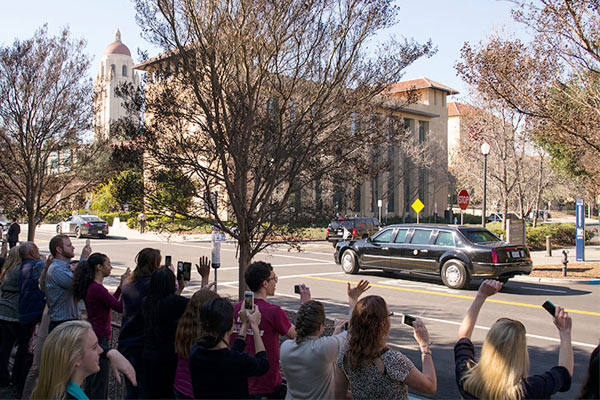
(Image credit: Aaron Kehoe)
11:20 a.m.
The presidential motorcade approaches the site of President Obama’s speech on cybersecurity
11:15 a.m.
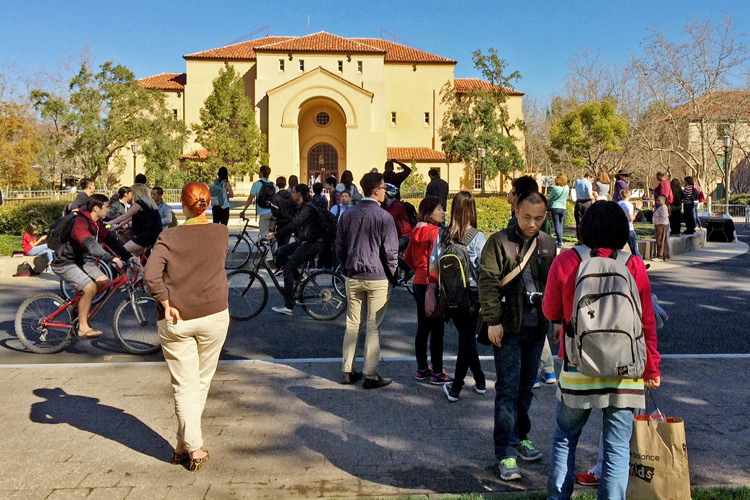
Serra Street outside Memorial Auditorium (Image credit: Brooke Donald)
Outside Memorial Auditorium, people started gathering in anticipation of the arrival of the president. Eyes (and cameras) gazed upward as a helicopter circled.
Yuki Bailey, a master’s student at the Center for Latin American Studies, stood with two friends just outside the security barriers. They all hoped for a peek at the president. Bailey said she was “pretty excited” the president is making a visit – not only because he’s the president but because Bailey, who’s from Honolulu, attended the same high school as Obama. “And I never got to see him when he visited there.”
She said the summit is also important, especially to students and researchers at Stanford, in the heart of Silicon Valley. “Technology is so prominent at Stanford and in Silicon Valley, and we need to be thinking about privacy and security issues.”
Despite the excitement, campus business went on as usual. Chatter from the crowd included discussions about road closures and access to offices. Tours of visitors made their way through the onlookers and students, and others biked by, en route to classes and elsewhere. And more than once, passersby stopped to ask what was going on.
10:45 a.m.
Apple CEO Tim Cook talked about security features in his company’s new payment system, which he called a huge improvement over a “little plastic card with a magnetic strip that we currently use.” The company doesn’t store a user’s credit card number or purchase history, he said, adding that information is between a person and the bank. In addition to applause over the company’s commitment to keeping financial and health information secure and private, Cook received cheers when he talked about the company’s commitment to the environment.
10:30 a.m.
Nuala O’Connor, president and CEO, Center for Democracy & Technology, spoke about the idea of the digital self. “In this always on, always connected world, we are always sharing data.” She pointed to the fitness tracker she wears, “Somewhere in this world someone is watching me right now.”
She said that people have the right to engage in the digital world without feeling exposed. “This is about my individual space,” she said. “I choose to be there, but at the end of the day, this is my personal data and we need to protect it.”
O’Connor gave a nod to her panelists, whose companies are working to develop methods of securing personal data in the financial and technology sectors. She said people need to be able to engage digitally and feel safe. Getting to this point is going to take better public-private collaborations, she said.
Renee James, president of Intel Corp., talked about how the company will implement the voluntary National Institute of Standards and Technology cybersecurity framework. The loudest cheers came when James said half of cybersecurity professionals will be women. She encouraged students to continue their math and science education.
“Women will fill half of the 220k open cyber jobs. Female students – stay in CS, we have jobs for you!” James said.
She went on to say that without the basic math and science education in K though 12, people can’t catch up. She encouraged her engineers do community service in the classroom.
O’Connor added to James’ comment her concerns about her own young girls continuing in science and computer technology. She and moderator Penny Pritzker, secretary of the U.S. Department of Commerce, encouraged the expansion of coding camps, especially for girls.
10:15 a.m.
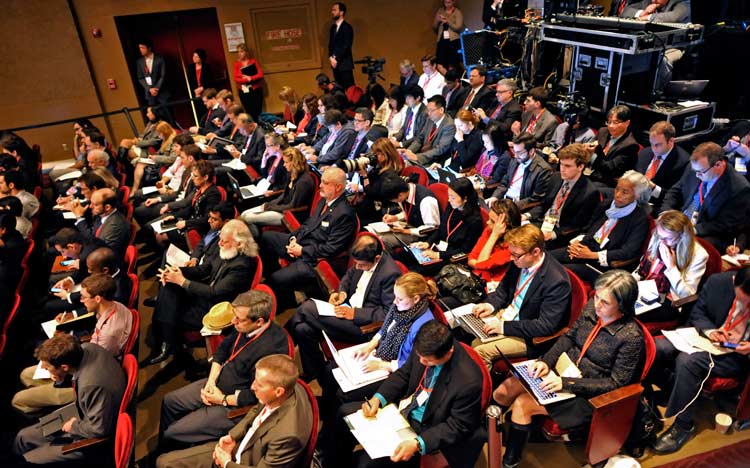
(Image credit: L.A. Cicero)
Media representatives and invited guests listen as experts from a range of sectors discuss ways to address current issues of cybersecurity and how to prepare the next generation for the future.
10 a.m.
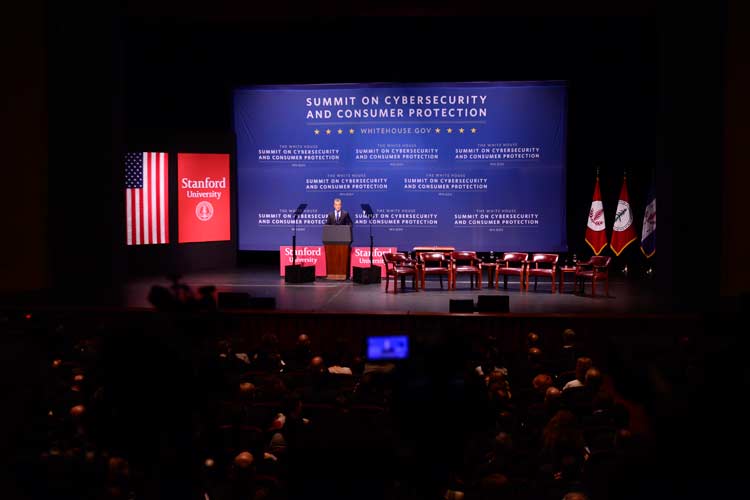
(Image credit: L.A. Cicero)
In Stanford University’s Memorial Auditorium, the stage was set for a dynamic discussion.
9:45 a.m.
Elizabeth Sherwood-Randall, deputy secretary, U.S. Department of Energy, talked about the challenges faced in the energy sector from cyber attacks, and addressed the attending students. She said these are some of the toughest challenges we face in the nation, and that makes them worth working on. “We need your minds, your talent and your energy.”
9:30 a.m.
Secretary Jeh Johnson of the U.S. Department of Homeland Security moderated a panel on how the government and private industry can work together to improve cybersecurity across the financial ecosystem.
Johnson, who was onstage with five other people all wearing blue and gray suits, said he felt conspicuous on the Stanford campus, to laughter from the students seated in the balcony. “This is a truly beautiful campus,” he said. “Those of you who go to school here are so fortunate.”
Johnson also told a story relating cybersecurity issues to college life. He went to visit his daughter at an unnamed Southern California university and had been told to dial back his entourage. When he showed up with just two – for him relatively discreet – security guards, the campus online communication network lit up. His son, visiting with him, hacked into the network and let the campus know that the disturbance was caused by a Vin Diesel look-alike (Johnson does look a lot like the actor).
The panel went on to discuss cybersecurity threats across financial, utilities, healthcare and government sectors, and how working together can increase security and reduce costs.
9 a.m.
Stanford President John Hennessy has opened the Summit, welcoming the participants, “particularly those from the East Coast.” He noted that cybersecurity is “a challenge that will demand a partnership” and that this meeting is designed to create a foundation for building that partnership.
President Hennessy also discussed the need for research institutions to educate the next generation of students about threats from cyber attacks and how to deal with them. He mentioned the recently launched Stanford Cyber Initiative, which creates an interdisciplinary environment bringing together students and faculty from computer science, engineering, business, law, policy and other fields to find solutions, and to educate the students who will be finding solutions to future threats. “Addressing these issues has the potential to make a profound difference for our economic competitiveness and in people’s lives,” he said.
7 a.m.
At the front of Memorial Auditorium, hundreds of students who had won the lottery for entry were already lining up, along with the invited business leaders, law enforcement and government officials. Amid the lines of patiently waiting people, what was noticeably absent (to a Stanford eye) were the usual swarms of speeding bikes along Serra Street. Inside, waiting for the upcoming plenary session and eventually President Obama himself, the conversations in the hallways have not to do with the summit, the threats we face in our increasingly connected age or the President. Mostly, the East Coast crowd seemed pretty thrilled about the weather.
3:45 a.m.
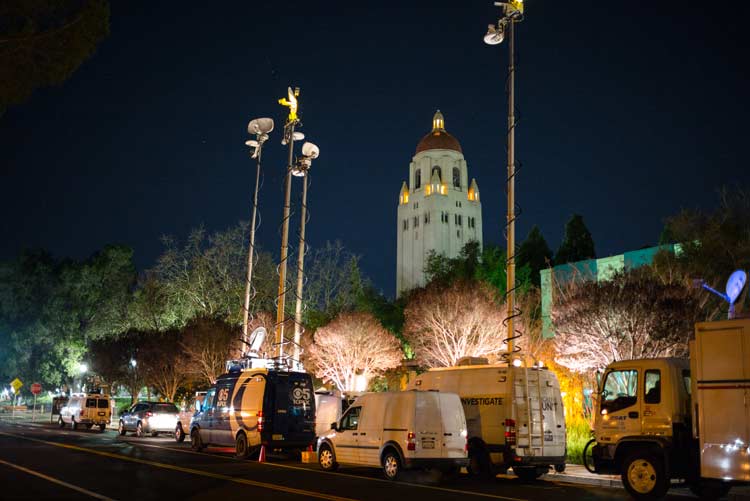
Media trucks line up along Galvez Street in predawn hours to cover the summit. (Image credit: Aaron Kehoe)
Media trucks began arriving in the middle of the night to cover the historic summit at Stanford, with more than 200 representatives of national, international and local broadcast, print and social media expected to attend.
Brooke Donald, Amy Adams, Heidi Beck, Bjorn Carey and Tom Abate contributed to this report.
